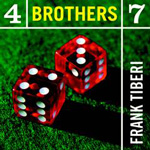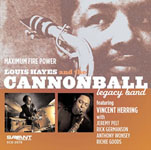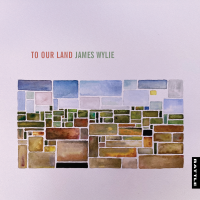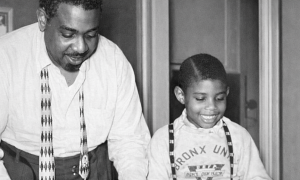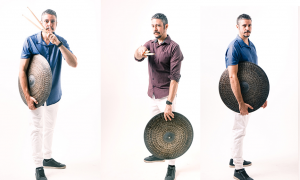Home » Jazz Articles » Interview » Joe DeRenzo: On the Comeback
Joe DeRenzo: On the Comeback
I looked up old musician friends after 9/11 and saw they were producing their own recordings and taking advantage of all the Internet and the technology was offering. Music once again became the reason I got up in the morning.
 You might say that jazz drummer Joe DeRenzo has a history of vocational commitment problems. After all, he has successfully pursued several careers and then abruptly left them behind. He was an up-and-coming pro drummer in fusion's heyday. He then left the music business to become an actor and was once offered help by a future Oscar winner!
You might say that jazz drummer Joe DeRenzo has a history of vocational commitment problems. After all, he has successfully pursued several careers and then abruptly left them behind. He was an up-and-coming pro drummer in fusion's heyday. He then left the music business to become an actor and was once offered help by a future Oscar winner!
He then became obsessed with a very unique and strange-looking camera he came across. He saw it as a tool to see the world in ways he had never seen it. He quickly became a professional photographer leaving his life as a thespian behind. As a photographer and graphic artist, he worked for and collaborated with American icon Peter Max. His music life was far behind him. In fact, the man didn't even pick-up a pair of drumsticks for fifteen years. But, the terrible thudding drumbeat of an historic event told him it was time to reevaluate his life. Music beckoned. That was six years ago. DeRenzo is now back in the thick of it.
core beliefs is DeRenzo's second CD since his return. I reviewed 2005's of night and day very positively. core beliefs is an outstanding work and evidence of his new ambitions. The album is a tribute of sorts to the sounds that influenced him the first time around. He was a great fan of the ECM and CTI jazz labels back in the late 1960s and early 1970s. To Joe, this recording is a celebration of the melodies and attitudes exemplified by those labels in those times.
He has arranged and contemporized pieces by Keith Jarrett, Joe Zawinul, Chick Corea and Lennon and McCartney. Though all the tunes are performed in the Western tradition, DeRenzo has added mid-Eastern, Eastern and Latin splashes here and there to create a worldly sound. To play these arrangements, he surrounded himself with some splendid musicians including Yellowjackets pianist Russell Ferrante and saxophonist Bob Mintzer, as well as pianist Tom Zink, among several others.
The acoustic album is almost free of any dissonance, but that doesn't mean its music isn't challenging. His arrangements are 21st Century emulations of what Ramsey Lewis, Herbie Mann, Hubert Laws and acoustic Joe Zawinul were doing with jazz back when it was still allowed to morph, flourish and grow in the popular sense. It is the kind of music that combines first-class chops with the hipness of musicians who have nothing to prove.
Beret-wearing DeRenzo has led quite an interesting life. He talks about some of it in an affable and engaging manner.
All About Jazz: I think many people would guess you were a New Yorker. But, you are actually a California guy.
Joe DeRenzo: That's true Walter. Anaheim, CA to be precise—hometown of Gwen Stefani, Disneyland and me.
AAJ: How did music enter your life?
JDR: Mainly from TV, although my dad always had records in the house like Sinatra, Ray Charles and an album by Louie Bellson entitled Around the World in Percussion (Roulette, 1961). Any time music was on the tube, and in those days jazz was allowed on the networks... he'd call me to watch it.
AAJ: Your first drumsticks were homemade.
JDR: Yes! I attended a Catholic military school in Anaheim and as with most military institutions, they had a marching band. When I saw the guys playing the snare drums and hearing that sound echo off the walls of the campus, I thought, "that looks like fun". And when I was five years old, fun was it! So one day I'm walking home from school and on the sidewalk was this two-foot long dowel. Back at my house I took a saw and cut it in half. That's how I fashioned my first pair of drumsticks. AAJ: Five years old and you were using a saw? That's impressive and scary at the same time. When did you first sit at a real kit?
AAJ: Five years old and you were using a saw? That's impressive and scary at the same time. When did you first sit at a real kit?
JDR: In 1968, when the whole hippie and flower-power thing was raging, my next door neighbor's son had fully embraced 1960s culture. One day there appeared a set of blue sparkle Ludwigs with Zildjian cymbals in his room. For me it was like viewing The Holy Grail. After a few tepid taps I was told not to touch them anymore. But, it was too late. I was hooked on the idea of "The Drums."
AAJ: What drummers drew your attention in the beginning?
JDR: Thanks to the Beatles' appearance on The Ed Sullivan Show, Ringo was probably the first drummer that made an impression on me. Years later when I got to meet him in New York, I couldn't help but think about seeing him on TV all those years ago. As a kid back then I wondered how he played the bass drum. I could see what his hands were doing, but I just assumed he was kicking the bass drum with his shoe. I didn't even know there was a pedal behind it!
AAJ: Who else?
JDR: I remember seeing a couple of album covers unlike anything I'd ever seen. Both had these three guys with hair that looked as if their heads had exploded. The albums were Cream's Disraeli Gears (Polydor, 1967) and Jimi Hendrix's Are You Experienced? (MCA, 1967). That's when I heard the music. So, in retrospect, it was the greats Ginger Baker and Mitch Mitchell that got me on my way.
AAJ: Concurrently, a visual art medium, photography, grabbed your interest. This would become an important part of your life and future career path.
JDR: The photography thing started in grade school. It wasn't until after high school that I attempted to explore imaging as an art-form.
AAJ: We'll get back to photography in a bit. But, how did you break in as a musician? What was the scene like?
JDR: I got my start like most—by playing in rock bands with friends at school. Then I went on the road a bit with my college jazz band. I can't really tell you what the scene was like because I certainly wasn't part of it. But, during high school I got my first real job at a small music store in my neighborhood. The guys that worked there took my under their wings and hipped me to everything going on in jazz at the time.
1974 was, to my way of thinking, an incredible time for discovering jazz music. The Crusaders, Herbie Hancock's Headhunters and Return to Forever were making a lot of noise. There were copies of Down Beat [magazine] always lying around the store. It was through that publication that I learned all about the jazz greats.
One day, while flipping through its pages, I saw an ad for a band. The guy in the ad was wearing this strange looking beanie. I showed it to the guitar teacher at the time, Alan Simcoe. "Oh yeah, Weather Report!" he said. "Those guys are out there." Intrigued, I went straight to the local record shop and asked, "What's the latest Weather Report album?" I was handed the album and went straight home, fired up the stereo, and put the needle down on the vinyl. By the time Mysterious Traveller (Columbia, 1974) was finished my mind had been transformed. The subsequent album Tale Spinnin'(Columbia, 1975) closed the deal. I was never the same again. I started consuming every jazz record I could get my hands on. I just took it all in.
AAJ: Many of us had experiences like that. What matters is the direction you choose afterward. Some of us become listeners, others become players. But, we all become important participants. Did you find other musicians with like minds at the time?
JDR: In the early 1980s, I met pianist Tom Zink at a Saddleback College Jazz Band concert.
AAJ: Tom would become a huge part of your comeback, but didn't you start to drift away from music during that time?
JDR: It happened over a couple of years. In 1985, I was working in Las Vegas with The Dae Han Sisters. During this time, my interest in movies turned into an obsession. After the gig, I began studying film and theatre in Hollywood with Jack Manning. I also worked as an extra in TV and movies. By 1987, I was in The Screen Actors Guild and doing the whole Hollywood routine.
One job had me decked-out as a bebop era jazz musician! After the day's production wrapped, a car pulled up to me as I was leaving and the guy blew the horn. To my amazement, it was the star of the film I had just worked on. "Hey man! You need a ride to your car?" he asked. I nodded and got in his Jeep. He wanted to know if I had a part in the movie? I told him I was just an extra. Then he asked if I had a headshot and a resume? I pulled them from my bag. "Cool," he said. "I'll give these to the director. Ya never know." So he dropped me off at my car and that was that. Nothing ever came of it and the day's shoot I was in didn't even get used. But, I had fun. The movie was Bird. The guy driving the jeep was Forrest Whittaker. What a nice guy. This year he wins the Oscar so my story becomes even cooler!
AAJ: Quite cool. And by the way, it appears you have kept that bebop wardrobe from the movie! So we go from music and photography to acting and back to photography? JDR: For much of the 1990s I pursued my photographic interests with a special panoramic camera called a Noblex. It has a lens that swings from left to right and would always get the funniest looks from people as I worked it. In 1997 I was shooting stock photos in Manhattan. It was a gloomy day in September on Lexington Ave and I wasn't having much luck getting any shots when out of the corner of my eye I see this guy walking out a door with a cell phone up to his ear. I instantly recognize him and start taking his picture. As the lens is swinging around, he sees me and starts walking in my direction. He asked me all about this crazy camera and invited me to his art studio on the Upper West Side. That's how I met Peter Max. After a couple years working on projects for him from Seattle, I moved to NY to work for him full time.
JDR: For much of the 1990s I pursued my photographic interests with a special panoramic camera called a Noblex. It has a lens that swings from left to right and would always get the funniest looks from people as I worked it. In 1997 I was shooting stock photos in Manhattan. It was a gloomy day in September on Lexington Ave and I wasn't having much luck getting any shots when out of the corner of my eye I see this guy walking out a door with a cell phone up to his ear. I instantly recognize him and start taking his picture. As the lens is swinging around, he sees me and starts walking in my direction. He asked me all about this crazy camera and invited me to his art studio on the Upper West Side. That's how I met Peter Max. After a couple years working on projects for him from Seattle, I moved to NY to work for him full time.
AAJ: Obviously Peter was very impressed with your artistic talents. You photographed for his archives. I know he is a music fan as well and was a kindred spirit. But, what made you leave your successful photographic job to return to music?
JDR: 9/11. It made me start to think about music again. I thought about the things I had not accomplished. Things crystallized. You started to think whether you were going to make it through the day. I just started thinking about music. I looked up old musician friends after 9/11 and saw they were using new technology that didn't exist before. They were producing their own recordings and taking advantage of all the Internet and the technology it was offering. Music once again became the reason I got up in the morning. I ended-up moving back to California to be near my musician friends... and to finish core beliefs.
AAJ: You are very effusive in the liner notes on these last two CDs about all the help and support you have received from your friends.
JDR: Without the friendship and talents of the other musicians neither CD would have happened. Since the early 1990s my friend from college, pianist Tom Zink, had been putting together his own recording studio and by the time I contacted him in 2003, he'd produced several CD and soundtrack projects. I hadn't spoken to Tom in nearly fifteen years. I tracked him down through the Internet. Tom and I had worked together with jazz guitarist Brian Hughes in the early 1980s and he was the only one I wanted to do these projects with.
AAJ: There was a time when the jazz business could afford many record labels. Some of them had their own signature sounds. You would almost buy the record because of the label!
JDR: ECM and CTI were jazz labels that influenced me a great deal. Airto, Hubert Laws, Deodato, Ron Carter, Gabor Szabo and Joe Farrell along with George Benson made some amazing albums for CTI. And the packaging was so cool. ECM had that very European sound that was so different with albums by Ralph Towner, Eberhard Weber and Jan Garbarek. Of course Keith Jarrett's solo piano albums were revolutionary. I was so blown away by Towner's Solstice (ECM, 1975) album.
AAJ: The arrangements on the new CD are wonderful. Joe, you are also a very fine drummer. But there are no drum solos on this record to speak of. Generally, though not always, drummer's albums feature at least a little bit of showing-off. JDR: Some drummers heading up a band might take that tact. And it's for that reason I didn't put any drum solos on the CD. There is a bit of one on "Dealing with my Demons towards the end, but the idea of using a CD project as a platform to feature one's drum chops is a bit predictable. I always want to go in the opposite direction from peoples' expectations.
JDR: Some drummers heading up a band might take that tact. And it's for that reason I didn't put any drum solos on the CD. There is a bit of one on "Dealing with my Demons towards the end, but the idea of using a CD project as a platform to feature one's drum chops is a bit predictable. I always want to go in the opposite direction from peoples' expectations.
I remember reading an interview with Roman Polanski about how he hates it when someone notices a particular shot in one of his films. It made him feel as though he hadn't done his job by making his technique disappear. I don't want anything distracting from the spiritual element the whole band is trying to create. I try to communicate an ideal circumstance and paint a picture with sound for the listener. People have told me the music sounds like a film soundtrack. That's the best compliment I can get. When I first heard Weather Report, the music created these vivid images in my mind unlike anything I'd experienced. I try and shoot for the same.
AAJ: If you were forced at gunpoint to recommend only one tune from core beliefs, what would it be?
JDR: The most satisfying track on the CD for me is "Second Sunday in August. It was the song that began to define the Weather Report sound and, oddly enough, was from their second album, I Sing the Body Electric (Columbia, 1972). Their version has more of a melody repeating throughout, but I wanted to have the sax stretch out and improvise more. Bob Mintzer did a great job on soprano as did Tom Zink on piano and Kevin Axt on bass. Kevin amazingly counterpoints Tom's lyrical piano part. Brian Hughes plays this intro on an Iraqi instrument called the oud.
The interplay between the musicians on a song like that is so important. After the first little section the rest of the song is Db sus. If you're not all listening to one another, there's a good chance a lot of musical toes will be stepped on!
I just have to mention "The Umbria Suite. I found a bootleg DVD of a Keith Jarrett solo piano performance from The Umbria Jazz Fest back in the mid-1970s. It was little more than a month before the sessions for core beliefs and, realizing that I didn't have enough material for a full album, I was scrambling for some more songs. I couldn't get the music from the solo concert out of my head and after a few listens I noticed three distinct ideas Jarrett was exploring. I started to play around with them on the piano and the idea for arranging them into a suite shortly followed.
Once that was done I got together with my friend and pianist Russell Ferrante to go over my little idea. He's got such a great foundation of the blues and gospel piano. These are signature attributes for Jarrett's style. Andonis Tsilimparis put his amazing voice to "Part III, and I'm very happy the way it all came together.
AAJ: You've recently signed a new recording deal.
JDR: I signed in January with ESC Records. My first CD release for the label is entitled Dante's View, referring to the point of interest in Death Valley National Monument. The cover shows the view of the valley below looking down on Badwater, an expansive salt-flat and the lowest elevation in the western hemisphere. It's one of my favorite places on earth. They've done a great job with the artwork too, which includes a few of my portraits of the other musicians.

AAJ: What is different about the music business this time around?
JDR: The big difference is the avenues of self-promotion via the Internet that weren't available before. Websites like CDBaby, Garageband and music pages on MySpace are incredible tools for networking with other musicians and introducing yourself to the world. Of course you still have to send out promo materials and write press releases, but the computer has made any kind of self-publishing so much easier. As far as disadvantages, if you're doing what you love to do, there aren't many. It's an amazing time to be making music as far as I'm concerned.
AAJ: What's on your plate now?
JDR: I'd like to do some live recording with my band and I'm working with Tom Zink and his wife, Anne Walsh, on her new CD. She sings on "Lenore, the Chick Corea tune, on Dante's View .We utilized her operatic voice with a nod to the Mahavishnu Orchestra's and Return to Forever's Gayle Moran. It came together beautifully. I'm looking forward to her making a big mark on the jazz scene.
As for me, I have come full circle. I now realize I was destined to be a musician. These other jobs were not detours at all. I now love playing the music, doing the artwork, taking the pictures, designing my web-page and creating the album covers that contain my music. They are now all a part of the same thing. They are part of me. This is what I am now. I think that is what core beliefs is all about.
Selected Discography
Joe DeRenzo, Dante's View (ESC, 2007)
Joe DeRenzo, core beliefs (DeRenzo Productions, 2006)
Joe DeRenzo, of night and day (DeRenzo Productions, 2005)
Photo Credit
Courtesy of Joe DeRenzo
Tags
PREVIOUS / NEXT
Support All About Jazz
 All About Jazz has been a pillar of jazz since 1995, championing it as an art form and, more importantly, supporting the musicians who make it. Our enduring commitment has made "AAJ" one of the most culturally important websites of its kind, read by hundreds of thousands of fans, musicians and industry figures every month.
All About Jazz has been a pillar of jazz since 1995, championing it as an art form and, more importantly, supporting the musicians who make it. Our enduring commitment has made "AAJ" one of the most culturally important websites of its kind, read by hundreds of thousands of fans, musicians and industry figures every month.


